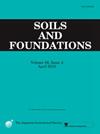Seismic performance of an existing anchored quay wall in the Ravenna port (Italy)
IF 3.3
2区 工程技术
Q2 ENGINEERING, GEOLOGICAL
引用次数: 0
Abstract
Evaluating the seismic performance of retaining walls is a significant engineering challenge due to non-linear soil-structure interaction, site response effects and ground motion properties. State of the art methods, based on non-linear dynamic analysis, are nowadays able to give reliable results when the numerical modeling is carried out with careful evaluation of seismic signals and appropriate choice of constitutive relationship for soils. However, a similar analysis is mostly restricted to relevant infrastructures. For large part of the practical situations, the simplified seismic analysis still represents the most used tool for design and verification. The new generation of Eurocode in Europe has introduced some innovations on the use of simplified seismic analyses making them more rationale and site-specific. In this paper, a case study involving the seismic evaluation of an existing anchored sheet-pile quay wall in the Ravenna port is presented. A well-known geotechnical setting and the data from an extensive field and laboratory investigation available for the area, allowed to perform both simplified and non-linear dynamic seismic analyses. The simplified seismic analysis according to the pseudo-static method outlined in the new draft of Eurocode 8 (FprEN1998:2024 TC250 – part 1 and 5), has been carried out and compared with the seismic performance of the quay wall evaluated through a 2D FEM non-linear dynamic analysis. Also, the seismic displacements of the quay wall from 2D FEM non-linear dynamic analysis were compared with recently proposed Newmark-type simplified methods. Relevant aspects of the presented case study are the very deep location of the bedrock, which required a separate model for site response analysis and 2D FEM non-linear dynamic analysis of the structures and the significant length of the wall embedment, due to poor geotechnical properties of the ground, which resulted in a pronounced spatial variation with depth of the ground motion.
拉文纳港(意大利)现有锚碇码头墙的抗震性能
由于非线性土-结构相互作用、场地反应效应和地震动特性,评估挡土墙的抗震性能是一项重大的工程挑战。目前,基于非线性动力分析的方法,在对地震信号进行仔细评估和适当选择土的本构关系的情况下进行数值模拟,能够给出可靠的结果。然而,类似的分析主要局限于相关的基础设施。在大部分实际情况下,简化地震分析仍然是最常用的设计和验证工具。欧洲新一代的欧洲规范在简化地震分析的使用上引入了一些创新,使它们更加合理和具体。本文介绍了拉文纳港现有锚固板桩码头墙的地震评价实例。众所周知,该地区的地质技术背景和广泛的现场和实验室调查数据,允许进行简化和非线性动态地震分析。根据欧洲规范8新草案(FprEN1998:2024 TC250 - part 1和part 5)中概述的拟静力法进行了简化的地震分析,并与通过二维有限元非线性动力分析评估的码头墙抗震性能进行了比较。同时,将二维有限元非线性动力分析得到的码头墙体地震位移与近期提出的newmark型简化方法进行了比较。所提出的案例研究的相关方面是基岩的非常深的位置,这需要一个单独的模型进行现场响应分析和二维有限元非线性动力分析的结构和墙体嵌入的显著长度,由于地面的岩土性能差,导致地面运动的深度明显的空间变化。
本文章由计算机程序翻译,如有差异,请以英文原文为准。
求助全文
约1分钟内获得全文
求助全文
来源期刊

Soils and Foundations
工程技术-地球科学综合
CiteScore
6.40
自引率
8.10%
发文量
99
审稿时长
5 months
期刊介绍:
Soils and Foundations is one of the leading journals in the field of soil mechanics and geotechnical engineering. It is the official journal of the Japanese Geotechnical Society (JGS)., The journal publishes a variety of original research paper, technical reports, technical notes, as well as the state-of-the-art reports upon invitation by the Editor, in the fields of soil and rock mechanics, geotechnical engineering, and environmental geotechnics. Since the publication of Volume 1, No.1 issue in June 1960, Soils and Foundations will celebrate the 60th anniversary in the year of 2020.
Soils and Foundations welcomes theoretical as well as practical work associated with the aforementioned field(s). Case studies that describe the original and interdisciplinary work applicable to geotechnical engineering are particularly encouraged. Discussions to each of the published articles are also welcomed in order to provide an avenue in which opinions of peers may be fed back or exchanged. In providing latest expertise on a specific topic, one issue out of six per year on average was allocated to include selected papers from the International Symposia which were held in Japan as well as overseas.
 求助内容:
求助内容: 应助结果提醒方式:
应助结果提醒方式:


